Citizen Sleeper 2 goes even harder on its RPG roots with its bold new twists on its tabletop dice rolls
Stress to success.
At first glance, Citizen Sleeper 2: Starward Vector looks and feels just like the original we know and love. As I catch up with the sequel's new, standalone android protagonist and their fellow shipmate Serafin on the small space station of Hexport, the most important tasks on their agenda have a pleasing familiarity to them: get some cash, stock up on supplies, and poke your nose in with the locals. You're both still feeling a bit highly strung after your escape from gang leader Laine - which we saw play out in explosive fashion during its animated reveal trailer last year - but for now, at least, you've got a small window of time where you can take a well-earned breather, and gradually adjust to your new life on the run.
But as I eased myself back into the rhythm of rolling dice to perform my daily tasks and enquiries, it wasn't long before I noticed a few new wrinkles in my Sleeper's routine. You'll still need to keep a weather eye on your energy bar, for example, but the long Stabilizer gauge that governed your overall health and number of dice rolls each day is nowhere to be found. Indeed, Laine himself is part of the reason why you're no longer dependent on these precious vials, and as you can imagine, he's not best pleased that his prized android has not only scarpered into the stratosphere, but also stolen one of his ships in the process. It's this ship you'll need to return to each night to refresh and regroup, but this time it's not just you who'll be calling it home.
Your buddy Serafin is just one of several crew members you'll be bunking with during Citizen Sleeper 2, and I get to meet two more of them right here in Hexport. Nia is a salvager looking to finally step out from underneath her brother's overprotective shadow, and you get the feeling she sees your ship as her ticket to freedom. Thing is, if you agree to take her out on one of your big contract jobs, her brother Femi won't be happy that you just spirited her away without asking for permission first. He'll demand his cut of your new windfall, souring your hard-won victory. Then again, if you say no to Nia upfront, then you might never be able to recruit her at all, either now or in the future.
Whatever you choose, it's clear the impact of your decisions will ripple out much further than they did in Citizen Sleeper 1, and part of me is almost glad that I ended up meeting Nia after I'd completed my first beginner contract. I still have every intention of taking her with me when I eventually do leave Hexport, of course, but at least I can delay her Femi's rage now until my next visit back here. And you will be coming back here, I might add, as all of Citizen Sleeper's ten hub worlds in the Starward Belt are designed to be flitted between several times over the course of your journey. You will, of course, need to make sure you have enough fuel and supplies to make each journey before you commit to it, and developer Gareth Damian Martin tells me you'll also be able to upgrade your ship with bigger engines and extra fittings to pass through additional hazards such as debris fields and radiation zones later on.
Juni, meanwhile, practically forces her way onto your ship, claiming she's an old friend of the shipfitter Karsten. You can tell right from the off there's something fishy about her, but her offer's also exceedingly tempting. While Karsten's more than happy to replace one of your ship's broken feed pipes (for a sizable fee, naturally), he's also prepared to cut you a deal if you go and retrieve a certain data core for him from an old, abandoned shipwreck nearby. Other salvagers don't dare go near it for fear of the ship's fearsome security protocols, but your stolen Rig just so happens to originate from the same corporation, which Karsten's banking on will be able to bypass its nasty self-destruct system. Oh good. Just what I wanted after a heart-pounding escape for my life. Sign me up three times over, why don't you?

As I left Karsten's workshop, I began weighing up my options. I could decline the contract outright and simply grind my way toward his outrageous fee by doing other odd jobs around the colony. But I've only got so long before Laine and his goons catch up with me, and ehhh… I'm not confident I'd be able to make enough money in the number of cycles I've got. Equally, if I do take the contract, this is a job that's clearly going to need someone with skills my Sleeper (or Serafin, for that matter) simply doesn't possess. I chose the Extractor class, you see, who are hardier kinds of Sleeper built for physical labour. Their strengths lie in physical endurance and engineering; not interfacing with machines and having good intuition to know when things are turning south. In fact, in another new change for Citizen Sleeper 2, my Extractor's Intuition skill is simply non-existent. My Interface skill could be levelled up over time, but Intuit is completely blocked off in my skill tree - and each class in Citizen Sleeper 2 will have its own Achilles' Heel like this.
It's a move that Damian Martin says was important for helping them to "clarify each class into a very specific experience" in Citizen Sleeper 2, as they found that players in the first game simply ended up maxing out their skill tree to become a jack of all trades because there was so much freedom in how you could apply your drive points. Any role-playing they might have done gradually wore away to nothing as a result, but this is something Damian Martin is keen to double down on in the sequel, knitting together the game's mechanical systems and expressive role-playing to form a much stronger kind of connective tissue.
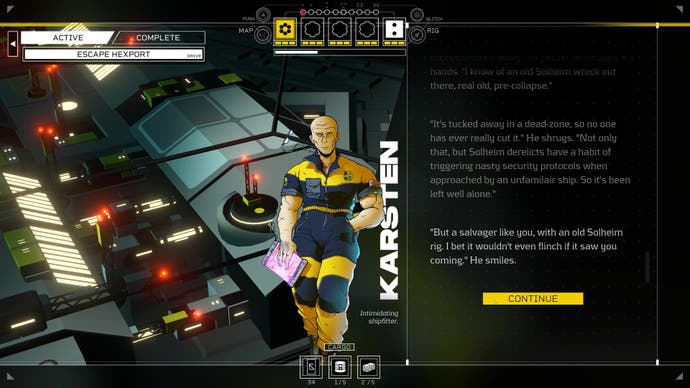

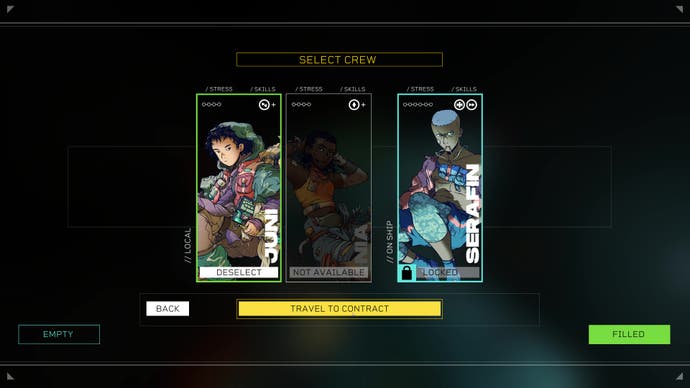
Naturally, these kinds of deficiencies also open the door for your newfound crew members to step in and pick up the slack, and even though Juni's introduction is sketchy as anything, the carefully wrapped, cat-sticker-laden keyboard tucked under her arm (not to mention her rammed backpack full of trinkets, drives and cables) is all I need to know that, yep, I absolutely need her aboard for this contract, stat. Now all I needed was enough fuel to get there and back again, and enough supplies to sustain us all on the job. With each contract taking place in a dedicated - and often isolated - location, there's precious little opportunity to rest or resupply, so making the requisite preparations will be a big part of Citizen Sleeper 2's ongoing cadence. Neither resource come cheaply, either, and it took a couple more cycles of scrimping and saving before I felt ready to take it on.
Of course, the fact that these missions even have this kind of build-up period is quite the marked change from the gentle moseying of Citizen Sleeper 1 - and based on my experience with the demo, they'll create much larger peaks and troughs in its overall structure, infusing them with a much greater sense of urgency and drama. Indeed, Damian Martin describes them as being like "side episodes of a TV show," citing Firefly and Farscape as two key reference points. "The contracts are a nice way to have these little episodes everywhere that tell you a bit more about the world and the characters," they say, and they'll come in all shapes and sizes.
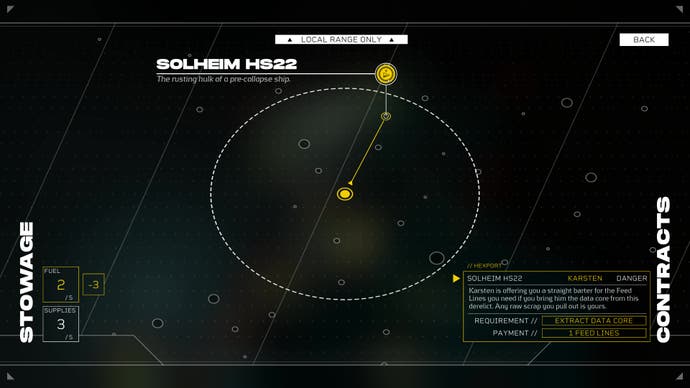
This one, though, really felt like a much more major event than anything else I've seen in Citizen Sleeper 1 - either in the base game or its DLC - and by the time I was in the final stretch, it had the same climatic tension as a series finale of your favourite TV show. Everything came right down to the wire, my final dice roll clinching victory from the jaws of impending doom. I very almost didn't make it, and Damian Martin reveals to me afterwards that this particular contract is actually "designed to be very fail-able", and that's okay, they say. "I try to be like a benevolent DM and just be like, 'Don't worry, the story's going to keep going and it will be interesting," and much like Citizen Sleeper 1, both success and failure will each have "a lot of complications" to sort out afterwards, they add. In fact, despite successfully extracting the data core in the nick of time, a last-minute twist from Juni completely up-ends what I do next. I go against my better judgment and actively choose to botch the contract, knowing deep down that it's probably (maybe) the right decision. Only time will tell, of course, but in the moment, it's a choice I feel completely justified in.
Whether any subsequent flops will continue to feel that good remains to be seen, of course, but high-stakes scenarios like this is only a fraction of what's driving Citizen Sleeper 2's newfound tension. The real beating heart of the game lies in its new stress system. Inspired by Damian Martin's other great love, tabletop board games, stress in Citizen Sleeper 2 is represented by ominous red notches above your dice. You, your crew mates, and (as it turns out) even the derelict ship I'm trying to break into will be able to accrue stress over subsequent day-night cycles, and the more stress you take on, the more damage it will do to your dice. Because yes, even the dice have health bars now, and once an individual dice has taken three points of damage, it will break completely and need to be repaired before you can use it again. It is, to some extent, a clever twist on the original's depleting Stabilizer gauge, but Damian Martin is keen to, err, stress that it's just "another mechanical way in which I'm trying to affect the player's experience".
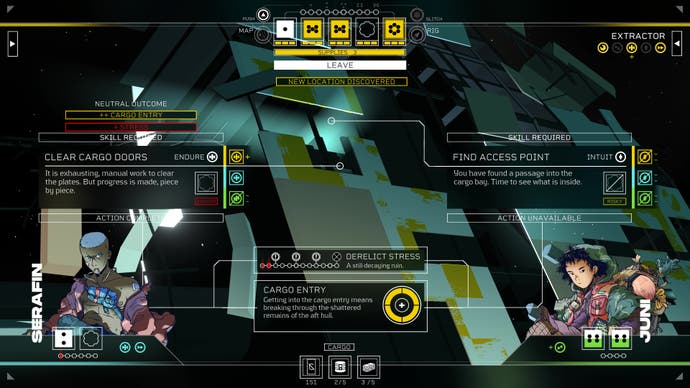
For them, stress is one of the most exciting ways of "building up tension in a way that isn't about taking damage," they tell me. "It can represent the stress of a conversation, or the stress of being chased by an alien, or the stress of, like, physical stress." It's more flexible than simple health damage in that sense, and the hope is that it will open up a wider range of avenues for Damian Martin to tell more interesting stories with.
It's also just a really neat way to give players another visual clue about their current state of mind. Citizen Sleeper's dice have always been a potent symbol for the condition of your android's body, "and so now a lot of the changes were about trying to add to that," Damian Martin says. "If parts of you are breaking, that means one of your dice is broken, and so you can look at the dice and see, oh, this is where I'm at right now. This is what my body looks like."
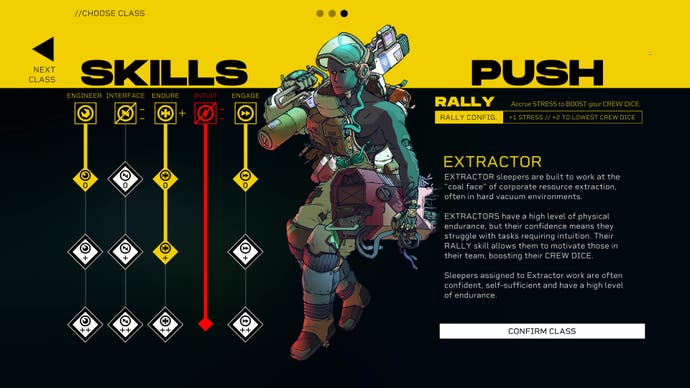
The same goes for your new, occasional glitching status, too - another cumulative effect that's an unfortunate byproduct of having been yanked out of a system reboot during your escape (you know what they say about never turning off your PC during an update!). Alas, I didn't experience this myself during my demo, but Damian Martin tells me that when your Glitch drive hits full, your dice will also start acting up, giving you an 80 percent chance of things going badly, but a 20 percent chance of the best possible outcome for that action. Damian Martin calls it their "little wild card", and while I'm not sure I'd ever be brave enough to risk such potential catastrophe, I love that it exists all the same, as it can only help pave the way for that kind of deep-seated role-playing that Citizen Sleeper 2's so clearly striving towards. The "unknowability of our own bodies," as Damian Martin puts it, is such a fascinating topic to explore in an RPG like this, and if the slightly later-game tease I'm shown after my demo ends is anything to go by, this journey of self-discovery will sit right at the heart of Citizen Sleeper 2's overarching story.
For now, though, I must simply leave my Sleeper to their fate back on Hexport. As my crew come to terms with the consequences of the decisions they made out in the Belt, I feel genuinely robbed when the screen fades to black and my demo comes to an end. I don't get to see what Karsten ends up making of our little arrangement with Juni, nor how it will affect our chances of making another hasty getaway before Laine's back on our tail again. But my time with Citizen Sleeper 2 has made one thing absolutely clear to me. There may be a different set of machines powering this ambitious RPG, but deep down, it still has the same gooey, human heart we know and love. This is a Citizen Sleeper sequel through and through, and I cannot wait to find out where it all leads early next year.



